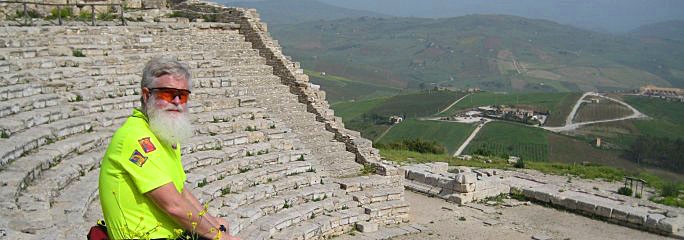Sicily looms large in the minds of Americans when they think of Italy because this, the largest island in the Mediterranean region, sent something like a million and a half Sicilians emigrants to the US in the early part of the last century. Indeed most of the Little Italy’s in the US were settled by Sicilians. This included many of the Italian populations in cities like New York (Little Italy), Chicago (Little Sicily), Boston (North End), New Orleans (Little Palermo), and San Francisco (North Beach).
Paola and I hitch hiked around Sicily in the 1970s and were struck by the numbers of drivers who picked us up with relatives in “Brooklino,” their version of Brooklyn! Just last summer I spent a week bicycling across central Sicily (check out my blog of the trip here) and not a day went by that I didn’t meet someone who had either grown up in the US or who was visiting family or exploring their roots.
Historically, Sicily offers one of the richest destinations in the Mediterranean basin. Because of its position nearly dead center in the Mediterranean Sea it has acted as an actual and figurative cultural bridge between east and west and between north and south for almost three millennia. The Phoenicians settled Western Sicily from modern day Syria and Israel in the first millennium BC while the Greeks vied for space in Sicily by mid-millennium and left some of the finest Greek temples anywhere at Segesta and Selinunte, both sites that we visit on our bicycle tour.
Bicycling to the Greek ruins of Segesta and Selinunte on this tour gives you an appreciation of real Mediterranean landscapes. The Greeks were particular about where they built their settlements: Segesta was an interior settlement with Castellamare del Golfo its principal port while Selinunte was a port on the south coast. You’ll learn to distinguish the olive trees with their grey-green leaves from the almonds with their bright green spring-fresh leaves as you pedal to these ancient Greek settlements. (Check out Paola’s recipe for a delicious Baked Lemon Almond Tart here.) On our ride to Marsala we visit the salt flats and Phoenician ruins of Mozia, one of the few Punic settlements left in Italy.
Rome, of course, fought Carthage for all of Southern Italy and Sicily in the second Punic War during the third century BC. And as the Muslim expansion eventually moved west through North Africa, Sicily became a natural stronghold from which the Muslim invaders attempted to dominate shipping and trade in the western Mediterranean basin in the 10th and 11th centuries. Today you can still find Islamic architecture and place names in Sicily and central Palermo retains the classic form of a typical Mediterranean an Islamic city with its narrow streets and blind alleys (a great reason to spend a couple of extra days in Palermo at the beginning or end of your tour!)
Because of its position as a crossroads of history, all of Southern Italy and Sicily became the target of Norman mercenaries, hired by the powers in southern Italy to keep the Muslims at bay in the eleventh century. By 1090 or so the Normans had consolidated control over most of southern Italy and Sicily. The result, today, is still blond and blue-eyed Sicilians in parts of Sicily, to the surprise of many.
Through the centuries Sicily remained strategic for many reasons. As the British merchant marine searched the world for fine wines in coastal towns they found Bordeaux in France(Claret in the 13th century), port in Portugal (Oporto), and sherry in Spain (Xerez della Frontera). In Sicily, perhaps one of the last of the fortified wines “discovered” by the British traders in the mid-18th century was Marsala from the town of the same name on the southwest coast. We bicycle through the famous Marsala vineyards and will do a tasting at one of the famous estates.
Marsala looms large in the history of modern Italy as the destination of Giuseppe Garibaldi in May 1860 when he set out from Genoa in the north to “liberate” southern Italy and Sicily from the centuries old rule of the Bourbon kings from Spain. Against all odds, Garibaldi landed his small army of a thousand “red shirts” in Marsala and stormed western Sicily, taking Palermo by surprise two weeks later. The defeat of the 20,000-strong Bourbon army in Palermo sent a shiver up the spine of Italy and through the Bourbon monarchy in Naples, setting the stage for the unification of Italy the following spring in 1861.
The ExperiencePlus! bicycle tour of Sicily, then, takes you layer by layer through the history of Western Sicily beginning in Palermo and continuing on to some of the best Phoenician and Greek ruins in the world. The tour includes Marsala wines, the ruins of Segesta and Sellinunte and the rich culinary traditions of Sicily. Special in 2010 are the preparations to celebrate the 150th anniversary of the liberation of Sicily by Garibaldi so be sure and visit the Garibaldi museum in Marsala to view some of the original “red shirts” of Garibaldi’s Thousand.


